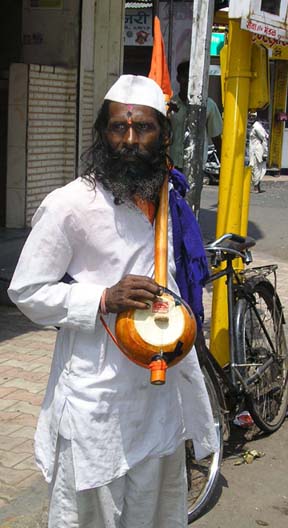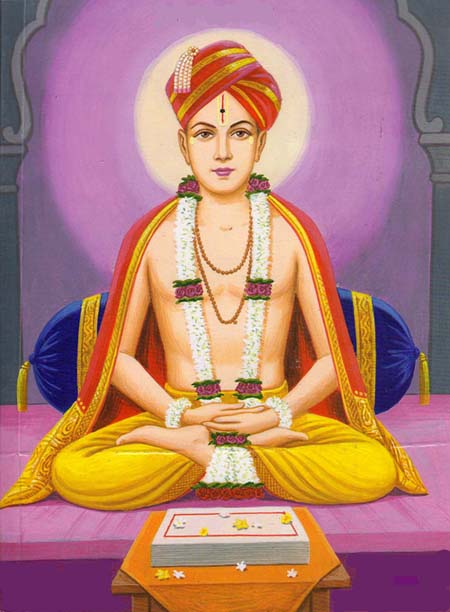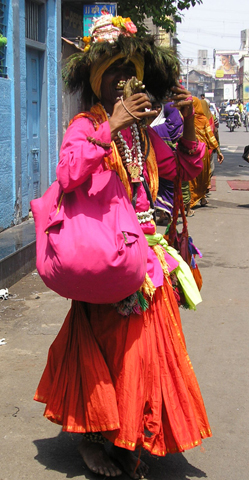The Philosophy of Varkari Sampraday
 The Varkaris believe in Supreme devotion to Lord Viththala and that true atonement or Moksha can only be reached by Bhakti or devotion. This bhakti is duty based and is conveyed through means of remaining loyal to one’s responsibility and commitments and by treating others with equality, dignity and respect. For Varkaris, Vari is not just a once-in-a-year kind of affair, but it is a way of life. There are set norms and guidelines that have been laid down and must be followed by each Varkari. These people do not belong to any one particular caste or class. They come from “athara pagad jaati” (18 different castes) which essentially means that there is no caste, class or religion barrier to become a Varkari. There are many known examples of several Muslims and Christians who are devout Varkaris. The proportion of minority classes from rural background is significantly large in the Varkari Sampraday. A Varkari is essentially of a ‘Satvik’ disposition he wears a Tulsi Mala (necklace of beads from Holy Tulsi plant) around his neck and never consumes alcohol or eats non-veg food. The person who wears a Tulsi Mala is also called Maalkari. These people work hard from dawn to dusk believing that they are serving Lord Viththala, they see Viththala in their crops, their livestock, vegetables they grow etc. Everything that they do, their belief is that they are doing it for their Viththala Mauli. After dusk, having put in a long hard day in their jobs, they meet together and sing songs of devotion to Viththala Mauli in the form or Bhajans, Kirtanas etc. A majority of the Varkaris in the state come from hard working farming communities and other similar professions. For them, Vari is a means of getting close to their beloved Lord and coming home refreshed, ready to take up the daily challenges of life. Vari coincides with monsoon season in India and it normally comes during the time when the farmers have finished preparing their farms for crops. They have finished ploughing and sowing in their fields and now they can only wait for the crops to come up. So they leave their daily grind and take a break for 20-21 days refreshing and rejuvenating their outlook, attitude, strengthening their convictions and chanting Harinaam.
The Varkaris believe in Supreme devotion to Lord Viththala and that true atonement or Moksha can only be reached by Bhakti or devotion. This bhakti is duty based and is conveyed through means of remaining loyal to one’s responsibility and commitments and by treating others with equality, dignity and respect. For Varkaris, Vari is not just a once-in-a-year kind of affair, but it is a way of life. There are set norms and guidelines that have been laid down and must be followed by each Varkari. These people do not belong to any one particular caste or class. They come from “athara pagad jaati” (18 different castes) which essentially means that there is no caste, class or religion barrier to become a Varkari. There are many known examples of several Muslims and Christians who are devout Varkaris. The proportion of minority classes from rural background is significantly large in the Varkari Sampraday. A Varkari is essentially of a ‘Satvik’ disposition he wears a Tulsi Mala (necklace of beads from Holy Tulsi plant) around his neck and never consumes alcohol or eats non-veg food. The person who wears a Tulsi Mala is also called Maalkari. These people work hard from dawn to dusk believing that they are serving Lord Viththala, they see Viththala in their crops, their livestock, vegetables they grow etc. Everything that they do, their belief is that they are doing it for their Viththala Mauli. After dusk, having put in a long hard day in their jobs, they meet together and sing songs of devotion to Viththala Mauli in the form or Bhajans, Kirtanas etc. A majority of the Varkaris in the state come from hard working farming communities and other similar professions. For them, Vari is a means of getting close to their beloved Lord and coming home refreshed, ready to take up the daily challenges of life. Vari coincides with monsoon season in India and it normally comes during the time when the farmers have finished preparing their farms for crops. They have finished ploughing and sowing in their fields and now they can only wait for the crops to come up. So they leave their daily grind and take a break for 20-21 days refreshing and rejuvenating their outlook, attitude, strengthening their convictions and chanting Harinaam.
Sant Dnyaneshwar and Sant Tukaram, saint-philosophers and poets are attributed with giving the Vari a sense of social significance by creating a fusion of religious philosophy with Karma and Bhakti. Sant Dnyaneshwar Maharaj laid down the foundation of Bhagwat Dharma which is the core philosophy of Varkari Sampraday. During the 13th century, Sant Dnyaneshwar wrote Dnyaneshwari also known as Bhavarth Deepika, when he was only 16 years old. It is a commentary on the Bhagvad Gita and has a great intellectual literary and aesthetic value. This sacred work is one of the foundations of Marathi language and literature along with works of other saint-philosophers such as Sant Eknath, Sant Tukaram, Sant Namdev etc. This book holds an extremely important place in the history of Maharashtra because in the earlier period, all works were in Sanskrit a language that was accessible to only select few. The knowledge contained in works such as Bhagvad Gita was denied to the masses and they only had to rely on what the so-called Pundits told them. Sanskrit was understood and studied by handful few. Therefore Sant Dnyaneshwar created the Dnyaneshwari in the language of the masses – Prakrut or Marathi. He wrote it in a very simple form using small phrases called ovis, illustrating with numerous, lucid examples. This book now forms the basis of the Bhagwat Dharma and the Varkari Sampraday. Not only the Varkaris, but the book is held sacred and valuable in all Marathi Hindu families and is the most widely read book in Maharashtra.
Vari - A Social Unifier
As I have mentioned above, Bhagwat Dharma and Varkari Sampraday grants an equal status to all human beings. There are no distinctions based on class, creed, religion, caste or gender. All men and women, no matter what religion or caste they are born in, no matter how high or low they are stationed in life, when they become Varkari, they are children of the beloved Vithu Mauli. No one is untouchable and no one is lowly. When Sant Dnyaneshwar laid down the foundation of Bhagwat Dharma in the 13th century, there was a complete state of anarchy under the rule of Yadavas which as further made worse by repeated invasions by Ala-ud-din Khalji and Muhammad bin Tughlaq. The social code of conduct was dictated by few Brahmins who laid down their own rules and regulations that were enforced upon largely illiterate and poor people. The downtrodden were exploited in every manner possible
with no way out. The Yadavas were overthrown by Muslims under whom the exploitation of poor folk increased manifold. Sant Dnyaneshwar showed them a way out by giving them Dnyaneshwari, which played a great role in creating awareness and awakening among the people. He united them against caste and class divide. His contemporary Sant Namdeo preached the philosophy of Bhagwat Dharma beyond the boundaries of Maharashtra right into Punjab. He composed 125 abhangas of which about 60 are included into the Holy Sikh Scripture, Guru Granth Sahib. For the downtrodden people, these two Saints along with many others were a ray of hope with new found purpose for life.

Later on about 230 years after Sant Dnyaneshwar, Maharashtra was even more ravaged under Muslim rule with repeated defeats by the invaders. The people had forgotten their epics, ballads, poems etc. and did not have anything to derive any kind of inspiration from. It was during this period that Sant Eknath sought out the forgotten Dnyaneshwari and revived it again. There are many epic works he wrote but his most significant work was introducing a new form of religious songs called ‘bharud’. Sant Eknath was the earliest social reformer who worked against untouchability at cost of great personal sacrifices and torture by others'. After him came another great saint Sant Tukaram, a contemporary of Chhatrapati Shivaji Maharaj and another great saint Sant Ramdas. While Sant Dnyaneshwar is considered as being the foundation of Bhagwat Dharma, Tukaram is considered to be its peak. He is considered the first modern poet in Marathi and is known for his famous Abhangs. Other notable saints associated with Varkari Sampraday are Nivruttinath, Sopan Nath, Muktabai, Janabai, Chokha Mela, Narhari Sonar, Sena Nhavi, Savata Mali etc. These great saints came from all walks of life, some of them were from minority and thereby shudra classes; but by their conduct, devotion and purity of heart they showed that all are equal in the eyes of god. Their efforts and works proved to be an inspiration for the people to remain united through centuries of foreign invasions and exploitations.
Today, as we have already entered into the 21st century, we are faced by a number of crucial problems. There are no invasions by foreign marauders but we are invaded by equally serious problems such as corruption, broken family and social structure, loss of morals and ethics etc. Slowly and gradually minor problems that we were seeing are becoming alarming major. Globalization has brought lot of comforts and riches but in many cases, they have resulted into degraded moral values and families are no longer united like they once were. Vari plays a significant role in bringing back those lost values. Many youth are now taking this pilgrimage to seek their own true selves. Once Vari used to be walked only by youth from rural areas, but the numbers of educated and well settled youth including IT professionals has increased a lot. Walking in the Vari has brought back the lost confidence for many, renewed the convictions of many and brought a major change in many lives. It is not just a pilgrimage of walking from point and reaching another, but it is more of reaching into the inner realms of our minds and seeking our inner self.
The Women in Vari
The participation of women, young and old alike is surprisingly high in Vari. For me personally, there is no other example greater than the Vari where women are considered as equals and it is perhaps the only time where women can behave naturally and quite freely. Walking for 20-21 days, eating and sleeping in open or in tents, bathing in rivers, they all are completely free from inhibitions of any kind. They chant harinaam, sing hymns, bhajans, play fugadis during stops etc. Essentially they are living their life with total abandonment. Almost all these women are from rural farming communities where they have nothing to look forward to but sheer hard work all of their lives, along with numerous restrictions and limitations that are already imposed upon them by a predominantly male-oriented culture. It is during Vari, that they get respite from all that and come home rejuvenated and refreshed, ready to take up the cudgels again against the daily grind. Illiterate though the women are their repertoire of numerous ovis and abhangas is astonishing. Their quick wit and a ready solution to all problems would put even an educated, tech-savvy young woman to shame. Their enthusiasm and energy is amazing. Their speed during the Ringan and Dhava would put even athletes to shame. These women do not expect nor are given any special treatment during Vari, they share equal responsibilities and duties during the journey. Thus unlike any other phenomenon in India or elsewhere, Vari, in my opinion, is a great leveler of all gender and class biases and therefore should be studied from this point of view.
Devotion Through Music and Dance

walking and during rest stops in Vari, after having food and other duties, the evenings and nights resonate with sweet voices singing Bhajans, Kirtanas, Bharuds, Gaulans etc. These are accompanied by various folk dances such as fugadi, pher, theka etc. Thus Vari is a complete embodiment of culture, heritage and history of Maharashtra, a complete show case of what being a Maharashtrian means and I am extremely proud to belong to this heritage.
Significance of Vari in the 21st Century
To conclude, Vari is significant and relevant as it was 1000 years ago. Through centuries Vari has served extremely important purposes of keeping the people united against foreign invasions, bringing about awareness against social inequalities and injustices, reforming and educating people in various social aspects etc. There is still a long way to go where social issues are concerned and that process is indeed happening. Today, when globalization has brought the entire world quite closer, problems are prevalent are now different than a few decades ago. The stress and strain of keeping up with careers, ambitions etc. are numerous which have resulted in decreased morals and ethics. Society is now more materialistic and individualistic than it was ever which has resulted in serious issues such as increased rates of divorces, suicides etc. When a person participates in the Vari, there are noticeable changes in his perception about life and general problems. Therefore each person must try to participate in Vari at least once during his or her lifetime and experience it firsthand. The mere sight of a poor farmer whose daily grind of life is unbearably hard, his efforts and perseverance to raise a decent crop against all odds and yet remain cheery and optimistic is a lesson of sorts. We do not need glamorous and expensive art of living lessons, but we only need to really LIVE LIFE; and that is what Vari does, it teaches us to live life, as it really should be lived.
(Continued from ....http://www.boddunan.com/articles/people-places/59-customs-and-culture/22765-pandharichi-vari-%E2%80%93-the-great-cultural-heritage-of-maharashtra-part-i.html)
Pictures: Author's Own